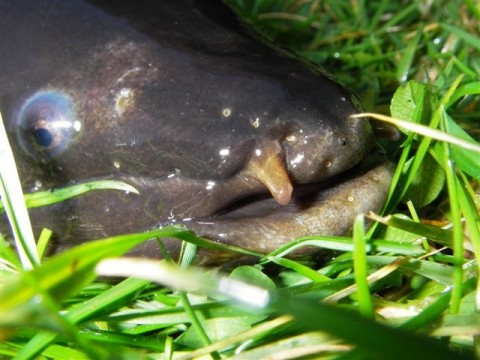Lifeline for Longfins
In rivers, streams and lakes throughout New Zealand, a certain species of native fish is preparing for one of the most epic journeys known to the animal kingdom. Every year, New Zealand longfin eels (Anguilla dieffenbachii), leave the freshwater environments in which they have spent many years and swim downstream and out to sea, where they carry on going, sometimes swimming at depths of 10 kilometres, never stopping to eat, until they reach the deep ocean trenches around Tonga.
 Here they congregate for a mass spawning event – the only one of their lives – before finally succumbing to exhaustion and lack of food. Their tiny offspring live on however, drifting on ocean currents all the way back to New Zealand. By the time they reach freshwater (not the same rivers that their parents came from) they are tiny, see-through miniatures of their parents called glass eels. They soon darken and begin their slow journey upstream to start the cycle all over again. Longfin eels (one of two main eel species found in New Zealand) are one of the biggest and longest-living eels in the world.
Here they congregate for a mass spawning event – the only one of their lives – before finally succumbing to exhaustion and lack of food. Their tiny offspring live on however, drifting on ocean currents all the way back to New Zealand. By the time they reach freshwater (not the same rivers that their parents came from) they are tiny, see-through miniatures of their parents called glass eels. They soon darken and begin their slow journey upstream to start the cycle all over again. Longfin eels (one of two main eel species found in New Zealand) are one of the biggest and longest-living eels in the world.
Historical records exist of individuals found weighing over 20 kg and some females live to be over 100 years old before making their breeding migration (that’s four human generations to just one eel generation!). For a species with very few natural predators, they have suffered hugely since humans arrived in New Zealand, through vast losses of habitat and through overfishing (every eel caught has never bred). Due to its unusual life history traits the longfin eel presents a unique conservation problem, as, on the one hand it is recognised as an endemic, threatened species in need of urgent conservation and on the other it is still commercially harvested! This is mostly because science moves slowly, and is finding it hard to keep up with the rate of eel declines and the general lack of knowledge about eel biology (such as how low can numbers get before they are unable to find each other in the ocean trenches and mass spawning failure occurs?).
The gathering of quantitative data about a species that possesses such enigmatic biological and ecological traits as the longfin eel is very difficult. All signs, however, are pointing towards quite dramatic declines occurring, with alarmingly skewed sex and size ratios evident in adult populations. The number of elvers arriving in New Zealand waters has declined by around 75 % and the amount of longfin eels caught by commercial fishers has dropped every year since they were first drafted into the QMS – no longfin quota in any fishing area, in any year has ever been met. This is even despite quotas being dropped significantly in 2007 as a result of concerns about declining eel numbers.
A growing number of New Zealand freshwater scientists are concerned that it may be too late to save this species unless action is taken immediately. Concerned stakeholders will be marching to Parliament on Tuesday to present a petition for a moratorium on the commercial harvest of longfin eels as one step towards effective eel conservation. You can contribute to this effort by raising awareness of how special longfin eels are and how precarious their position is. It would be a terrible thing for this beautiful, unique creature to join the ranks of those we have lost.
